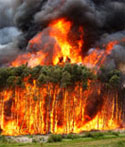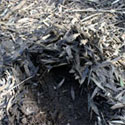Melaleuca and Fire
Fire is an important part of Florida's native ecosystems. Naturally occurring fires in Florida's natural areas have historically been ground fires that burn through low-growing grasses and bushes but characteristically do not reach the upper tree canopies. Many people are not aware that most of the South Florida wildfires now involve melaleuca. The introduction of melaleuca and its subsequent invasion into natural areas brought with it the increased occurrence of intense crown fires, something to which the Florida landscape and it inhabitants were unaccustomed.
Fires in wilderness areas either occur accidentally or deliberately. Accidental causes can be from lightning or careless human activity. Deliberately set fires are from either malicious human activity (arson) or prescribed by land managers. Generally speaking, all the fires other than prescribed fires are considered wildfires.
Not an ideal management tool
Fire is not an ideal management tool for melaleuca. It can be particularly risky in many upland habitats where melaleuca may be intermixed with desirable tree species such as pines or cypress. The risk exists because mature melaleuca trees will survive the fire while their papery bark and oil-rich leaves increase the fire's intensity to a level deadly to the other trees in the area. Also, many melaleuca infested areas are inaccessible to fire suppression equipment, making it more expensive and risky to use fire as a control method.
The TAME Project
- Welcome
- About Melaleuca
- Melaleuca & Fire
- Collaborators
Primary Funding Agency

Melaleuca crown fire

Melaleuca leaf litter also fuels fires

